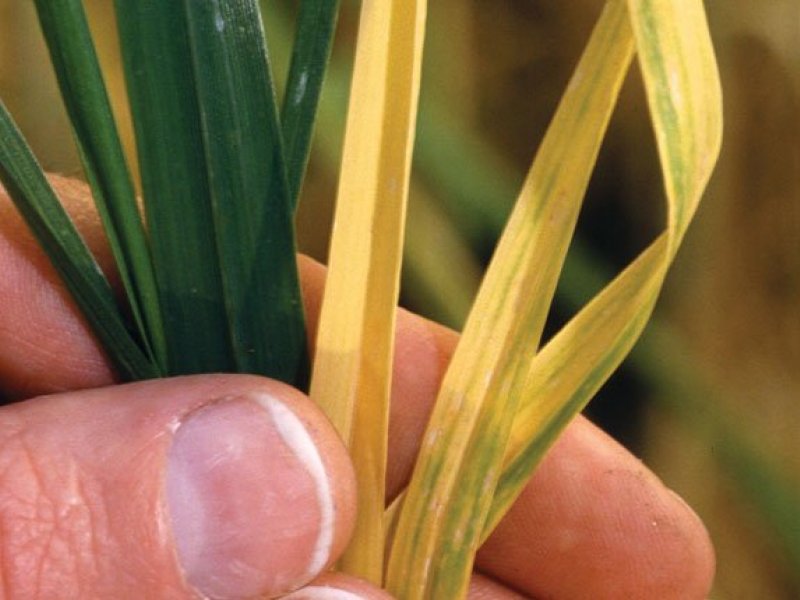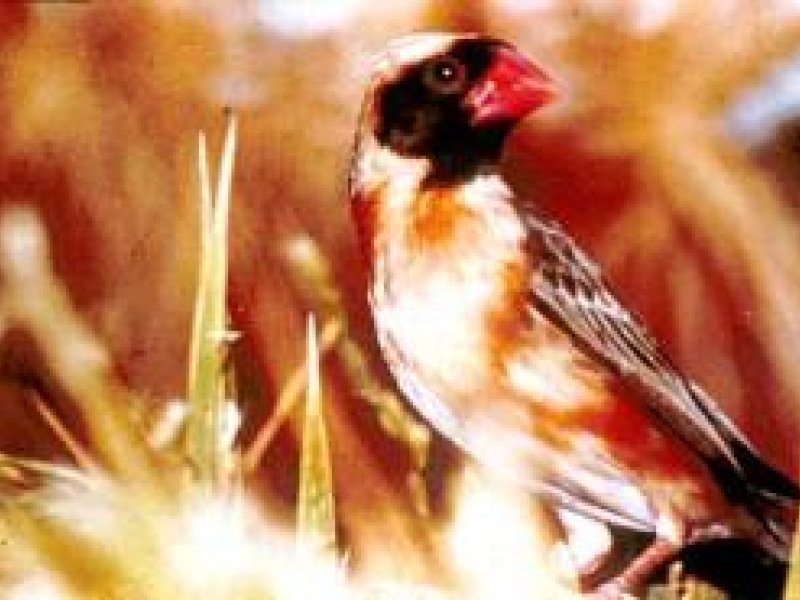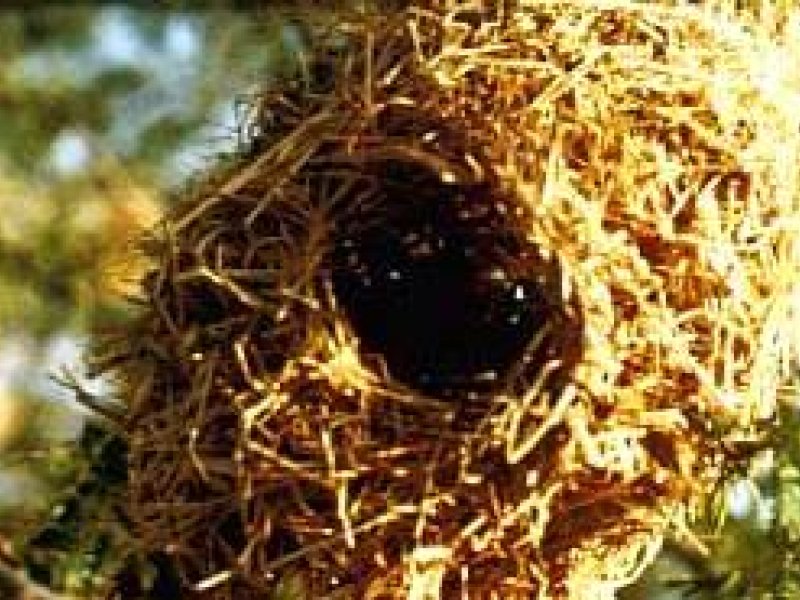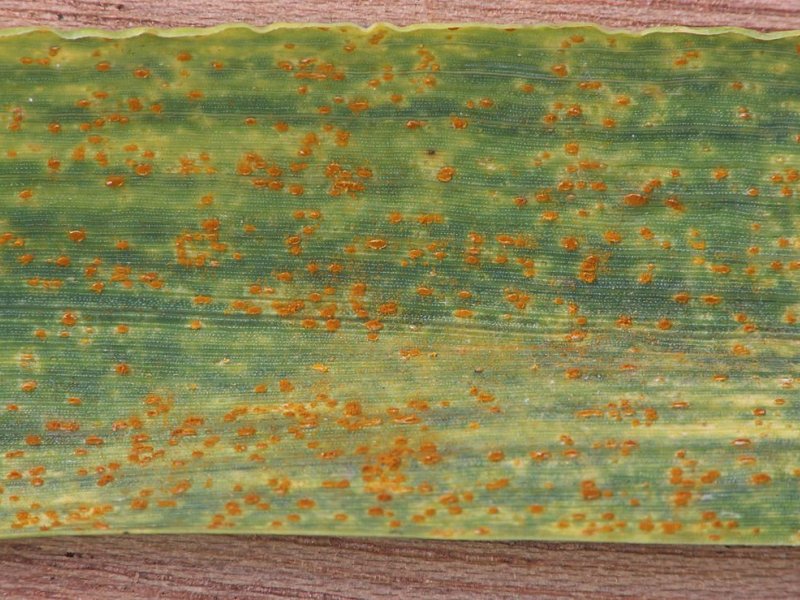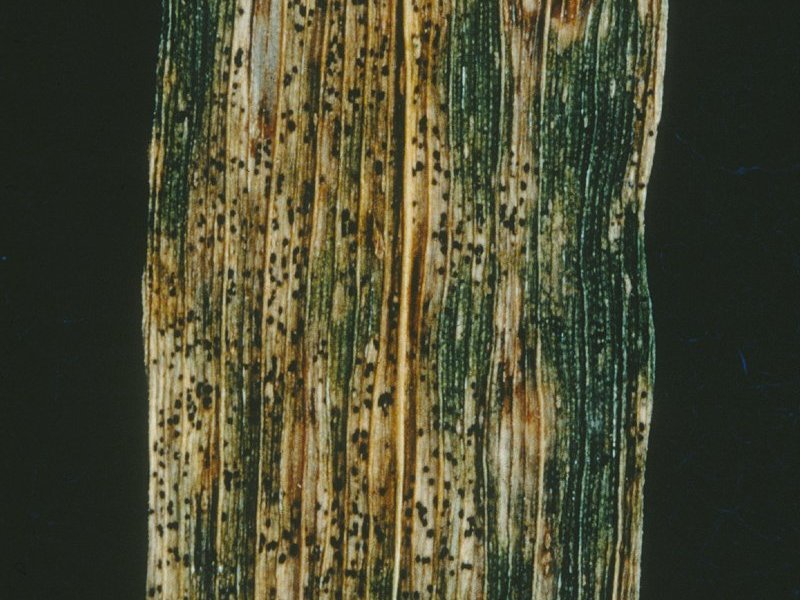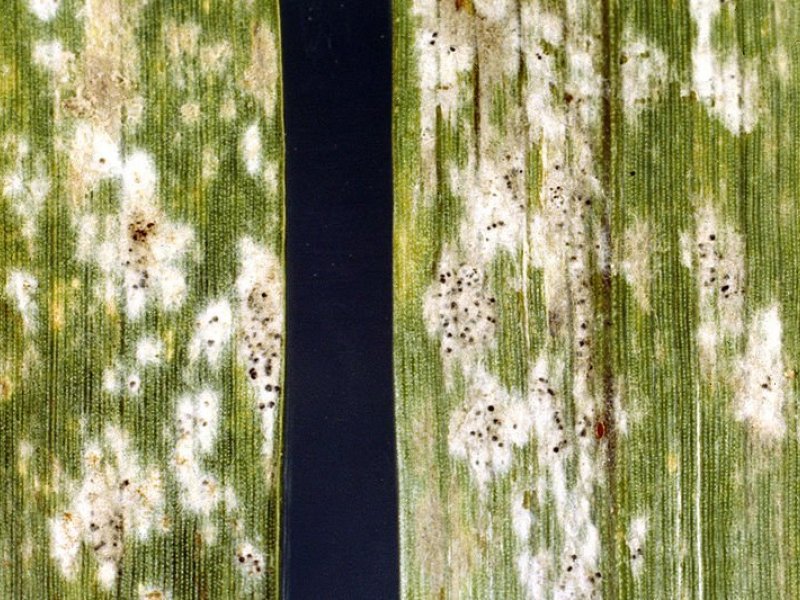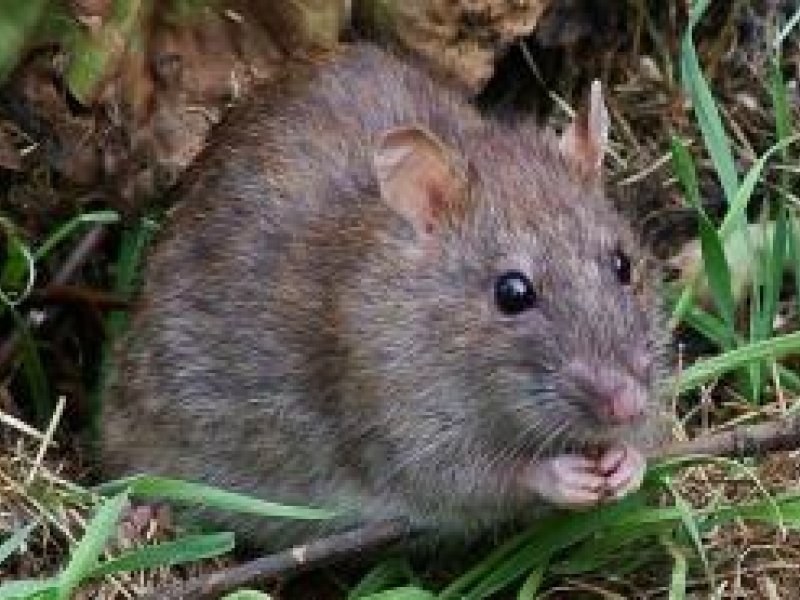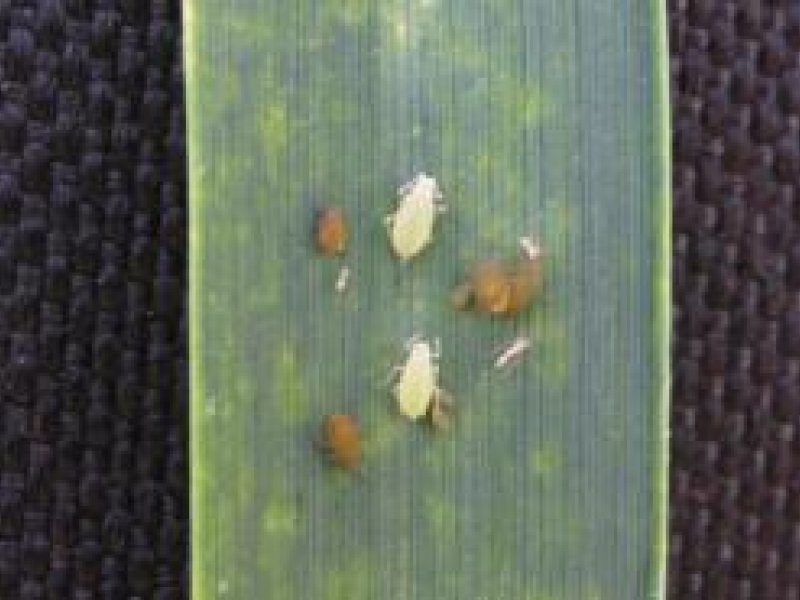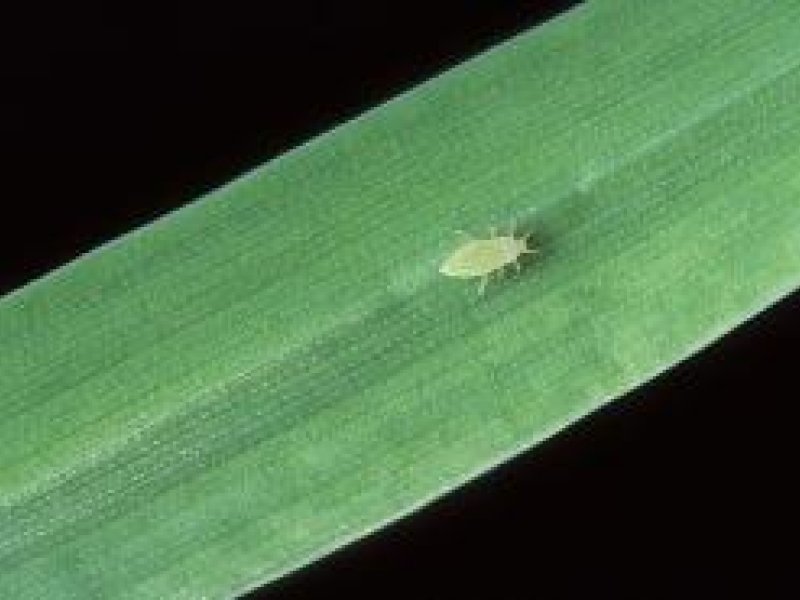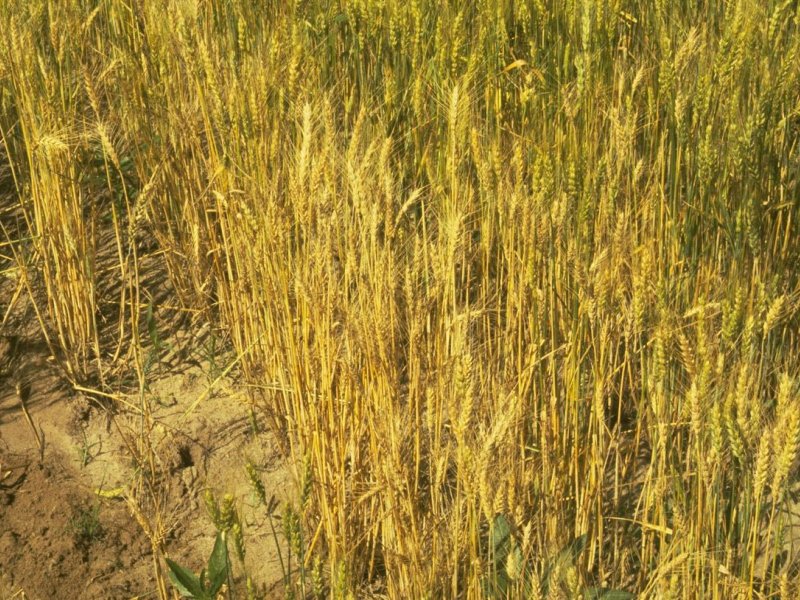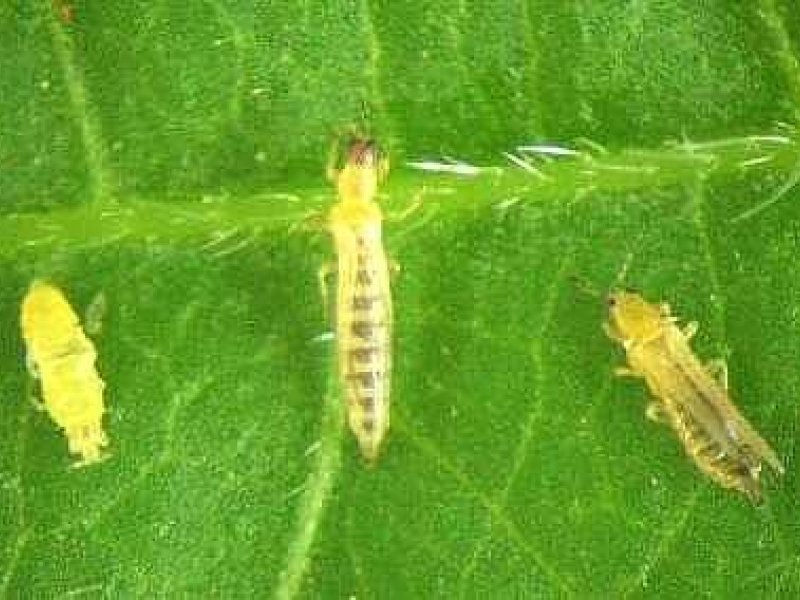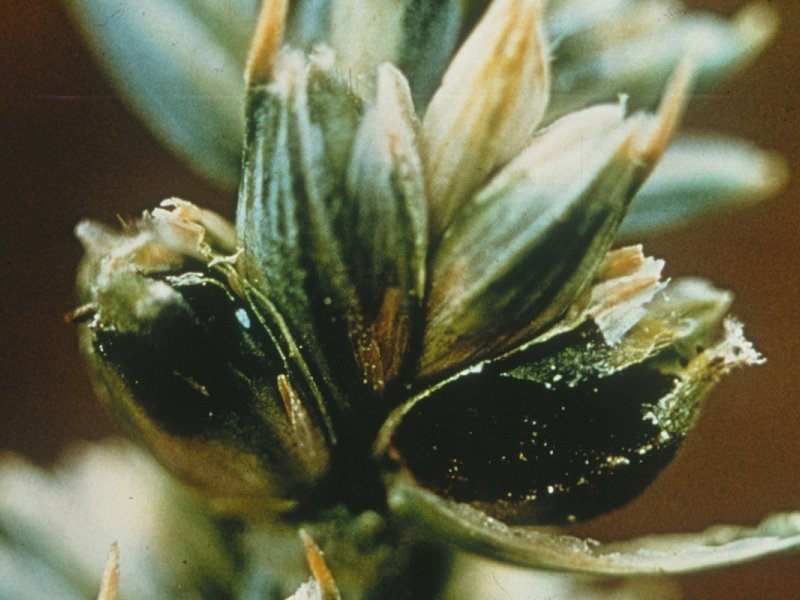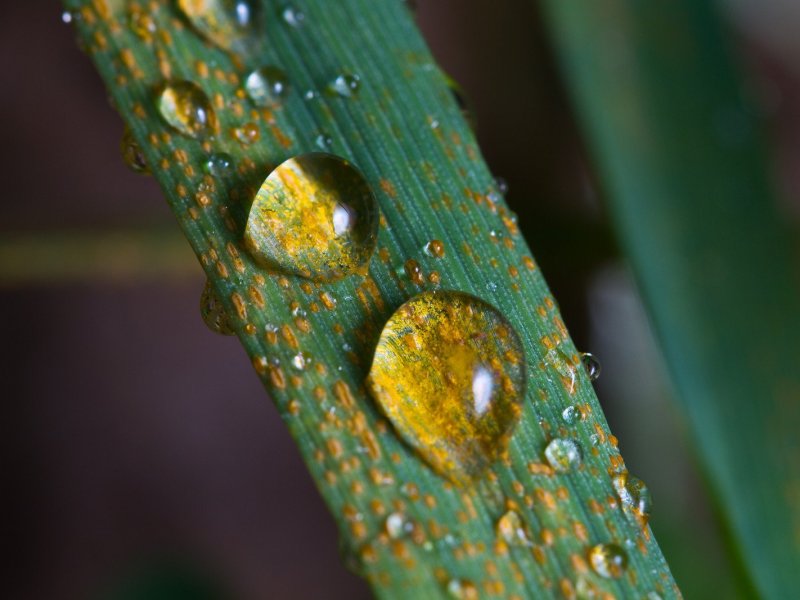|
Barley yellow dwarf virus (BYDV) (luteovirus) Symptoms include leaf discolouration from tip to base and from margin to centre. The discolouration takes on different colours depending on the plant. In barley, the leaf turns bright yellow; in oat, an orange, red or purple discolouration is seen and in wheat, rye and triticale, the infected leaves are generally yellow and sometimes red. Plants are usually stunted, with a decrease in tiller number and biomass and a weak root system. Suppressed heading, sterility and failure of grains to fill occur in the most severe cases. In the field, symptoms appear usually as yellow or red patches of stunted plants. The disease is most damaging in terms of yield reduction, if it infects a crop at an early stage of growth. The virus is spread by cereal aphids (e.g. Rhopalosiphum padi, R. maidis, Sitobion avenae, etc.). It is neither seed-borne nor mechanically transmitted. It also attacks maize, rice and several grasses. |
|
|
What to do:
|
|
Birds The red-billed quelea is a small weaver bird native to sub-Saharan Africa and renowned for its attacks on small-grain crops within Africa. It is the most numerous bird species in the world. The red-billed quelea is mainly granivorous, except when feeding its chicks insects or when eating insects prior to migration or breeding, and it relies on a supply of grass seeds to survive. When unable to find grass seeds or when opportunities arise, quelea will attack crops such as wheat, millet, oats, sorghum, teff, rice. It is a major pest throughout much of sub-Saharan Africa and can cause significant economical losses. The bird is inherently nomadic and this nomadism accounts for its invasions into areas where it was previously absent. |
|
|
What to do:
|
|
Brown leaf rust (Puccinia recondita f. sp. tritici) The lesions are brown at first and are most easily distinguished from those of stem rust by their size and shape: they are usually small and circular. They turn black as the crop matures. They occur on the leaf blades and the leaf sheaths and may appear at any stage of the crop's growth. |
|
|
What to do:
|
|
Glume blotch (Phaeosphaeria (Leptosphaeria) nodorum) It can cause considerable damage in wet years, especially where wheat has been grown for several years in succession. Symptoms consist of brown lesions on the glumes and around the nodes. At advanced stage of the disease black spots just like dots can been seen on the lesions. These are fungal spore bodies (pycnidia). The affected leaves become shrivelled with light brown patches on them. Glume blotch is spread by use of infected seeds, rain splash and infected crop residues. |
|
|
What to do:
|
|
Powdery mildew (Erysiphe graminis f. sp. tritici) White powdery growth appears on all above ground parts of plants. The white growth consists of fungal mycelium and spores. The growth later turns buff in colour. The disease is wind-borne. |
|
|
What to do:
|
|
Rats Rodents, mainly the black rat (Bandicota bengalensis), also damage stored seeds. |
|
|
What to do:
|
|
Russian wheat aphid (Diuraphis noxia) Cereal aphids, being vectors of virus diseases, such as the Barley yellow dwarf virus, can be serious pests in wheat. The important cereal aphids that attack wheat in Kenya include Schizaphis graminum, Sitobion avenae, Rhopalosiphum padi, R. maidis, Metopolophium dirhodum and Diuraphis noxia (the Russian wheat aphid). The Russian Wheat Aphid (Diuraphis noxia) is one of the most damaging pests of small grain cereals (e.g. wheat, barley, triticale, rye, and oats) in the world. This aphid is a relatively new pest of wheat in Kenya. It was first identified in farmers' fields in 1995. It then spread quickly to all the wheat growing areas of the country and it is nowadays the most important pest of wheat and barley. It is also a major pest in South Africa, but has maintained minor pest status in Egypt, Sudan and Ethiopia. The Russian wheat aphid is pale to light green in colour with an elongated, spindle shaped body and grows to up to 2 mm long. It has short antennae with rounded very short, nearly invisible cornicles. The feature that easily distinguishes it from other cereal aphids is the presence of an appendage above the cauda, which gives the aphid the appearance of having 2 tails. They prefer to live in the leaf whorls or in tightly rolled leaves, and thus are partially protected from natural enemies and from contact insecticides. They are hardy and can survive extremely low temperatures. Dry weather favours rapid increase of the aphid. Unlike many important cereal aphids, the Russian wheat aphid is not a known transmitter of diseases, but causes damage by injecting a toxin into the plants during feeding. This toxin prevents the production of chlorophyll and causes, in susceptible cultivars, leaf chlorosis, longitudinal leaf rolling and white/yellow (warm weather) or purple reddish (cold weather) streaking on the leaves. Extensive chlorosis leads to death of plants while leaf rolling retards plant development causing stunted growth. The tight rolling of flag leaves delays ear emergence, leading to floret sterile heads resulting in reduction of seed set. Aphid infestation also reduces the quality of the seeds produced, as shown by low kernel weight, increased rate of seed deterioration under accelerated ageing conditions, and reduced seedling vigour. The effect of infestation on seed quality is more pronounced under dry conditions. Infestation also may result in reduced seedling vigour. In Kenya, the damage usually appears when crops have attained the tillering stage. Yield losses ranging from 25 to 90% have been reported. |
|
|
What to do:
|
|
Stem rust (Puccinia graminis f. sp. tritici) It is characterised by pustules (a pimple-like or blister-like structure) that develop and break through the surface of the stems, leaves, sheaths, chaff and beards of the wheat plant. The kernels are badly shrivelled, many of them being so light and chaffy that are blown out with chaff in threshing. The remaining grains may be shrunken to one-half or two-thirds normal size. Myriads of brick-red spores escape from the pustules and are carried by the wind to other wheat plants. Wheat stem rust also attacks barley, occasionally rye and many wild grasses (Hordeum spp., Agropyron spp., Elymus spp., Hystrix spp. and some brome grasses). It does not attack oats. |
|
|
What to do:
|
|
Take-all disease (Gaeumannomyces graminis) It is a soil-borne fungus. It invades and blackens the roots, frequently killing them in the process. Affected stems are black and shiny just above the soil level. This symptom can only been seen by peeling away the leaf sheaths. The disease occurs in slowly widening patches, and in these areas plants with poorly filled or empty ears (whiteheads) may be present. The pathogen survives between crops on cereal roots and stubble. It also attacks barley, oats and rye. |
|
|
What to do:
|
|
Western flower thrips (Frankliniella occidentalis) The Western flower thrips (Frankliniella occidentalis). (Close-up) Inmmature thrips (left) and adults. Very much enlarged . Real size 0.9 to 1.1 mm. |
|
|
What to do:
|
|
Wheat bunt (Tilletia tritici) Infected plants have reduced height. The smutted wheat heads are bluish green when theyt emerge from the boot. The healthy heads are yellowish green. The disease also induces excessive tillering. The spores are blown by wind to developing ears which they invade. Bunt infected flowers have green ovaries while healthy ones are white. The grain of wheat is replaced by a black mass of spores (spore ball) accompanied by a smell like of rotting fish. |
|
|
What to do:
|
|
Yellow rust (Puccinia striiformis) The disease is also called stripe rust. Yellow or orange-yellow pustules develop on the glumes or chaff, on the leaves, and on the leaf sheaths. These lesions are arranged in parallel lines along the leaves. The disease may also attack the stems and the kernels. Infected leaves show distinct chlorosis. Damage to the disease is most serious, if plants are attack at milk stage or earlier. Under severe infection kernels may be shrivelled. Rapid disease spread is favoured by warm weather with frequent rainfall. Yellow rust also attacks barley, rye, and over 60 species of grasses. |
|
|
What to do:
|
Geographical Distribution in Africa
Geographical distribution of Wheat in Africa. Updated 28 November 2018. Source FAOSTAT.
General Information and Agronomic Aspects
Wheat is the most widely adapted cereal, being grown from sea-level to altitudes of more than 4500 m, and from the equator to within the Arctic Circle.
Wheat has been grown in East Africa since early 1900s and currently occupies the second highest production figures after maize. Early development of this crop was confined to large scale farms, but this pattern is changing with small farmers taking up wheat farming on smaller plots.
The demand for wheat flour in Kenya at present cannot be sustained by local production, so the country relies on import to meet almost half its consumption.
Wheat provides almost 20% of all human food energy. It is made into various products including bread (leavened, flat and steamed), chapaties, pastries, crackers, biscuits, pretzels, noodles, farina, macaroni, spaghetti, bulgur, couscous, breakfast foods, baby foods, and food thickeners. It is also used as a brewing ingredient in certain beverages.
Nutritive Value per 100 g of edible Portion
| Raw or Cooked Wheat |
Food %Daily Value*) |
Carbohydrates (g / %DV) |
Fat (g / %DV) |
Protein (g / %DV) |
Calcium (g / %DV) |
Phosphorus (mg / %DV) |
Iron (mg / %DV) |
Potassium (mg / %DV) |
Vitamin A (I.U) |
Vitamin C (I.U) |
Vitamin B 6 (I.U) |
Vitamin B 12 (I.U) |
Thiamine (mg / %DV) |
Riboflavin (mg / %DV) |
Ash (g / %DV) |
| Wheat flour white | 364.0 / 18% | 76.3 / 25% | 1.0 / 2% | 10.3 / 21% | 15.0 / 1% | 108 / 11% | 1.2 / 6% | 107 / 3% | 0.0 IU / 0% | 0.0 / 0% | 0.0 / 2% | 0.0 / 0% | 0.1 / 8% | 0.0 / 2% | 0.5 |
| Wheat flour whole grain | 339.0 / 17% | 72.6 / 24% | 1.9 / 3% | 13.7 / 27% | 34.0 / 3% | 346 / 35% | 3.9 / 22% | 405 / 12% | 9.0 IU / 0% | 0.0 / 0% | 0.3 / 17% | 0.0 / 0% | 0.4 / 30% | 0.2 / 13% | 1.6 |
*Percent Daily Values (DV) are based on a 2000 calorie diet. Your daily values may be higher or lower, depending on your calorie needs.
Climatic conditions, soil and water management
Wheat is essentially a temperate-climate crop. Optimum temperatures for development are 10 to 24°C. RelativeIy low temperatures result in the highest yields. Temperatures above 35°C stop photosynthesis and growth, and at 40°C the crop is killed by the heat. In tropical areas, wheat is best grown at higher elevations or in the cooler months of the year. The minimum amount of water required for an acceptable crop is 250 mm in the top 1.5 m of soil. Areas with 700 to 1000 mm rain per year will be able to grow rain fed wheat.
Wheat does not grow well under very warm conditions with high relative humidity, unless irradiation and nutrient availability are very favourable. In addition, wheat diseases are generally encouraged by such climatic conditions.
Soils best suited for production are well aerated, well drained, and deep, with 0.5% or more organic matter. Optimum soil pH ranges between 5.5 and 7.5. Wheat is sensitive to soil salinity.
Wheat varieties
Successful wheat production depends on knowledge about suitable varieties for the area where wheat production is planned. The varieties which are recommended have good stem rust resistance, are medium to high yields and have acceptable baking quality. To reduce risks due to seasonal climatic variation, it is advisable to plant at least 3 of the recommended varieties.
List of some recommended wheat varieties in Kenya:
| Variety Name | Altitude (m) | Yield (t/ha) |
Days to maturity | Special attributes |
| "Kenya Pasa" | 1800-2400 | 2.3-6.7 | 130 | High yielding, resistant to lodging |
| "Kenya Chiriku" | 1800-2400 | 2.6-6.0 | 130 | Resistant to rust |
| "Kenya Mbuni" | 1800-2400 | 2.8-6.0 | 130 | High yielding |
| "Kenya Kwale" | 2100-2400 | 2.8-6.7 | 130 | High yielding, tolerant to sprout |
| "Kenya Popo" | 1800-2400 | 1.3 | 140 | Good tolerance to stem, ear and yellow rust.Good tolerance lodging but poor to sprouting |
| "Kenya Fahari" | 1800-2400 | 1.1-1.6 | 120 | Resistant to Russian wheat aphid |
| "Kenya Kongoni" | 1800-2700 | 1.3-1.6 | 130 | Acid soil tolerant |
| "Kenya Nyumbu" | 1800-2700 | 1.3-1.8 | 130 | Resistant to stem rust |
| "Kenya Nyangumi" | 1800-2100 | 25 | 130 | - |
| "Kenya Paka" | 1800-2100 | 24 | 120 | - |
| "Kenya Kulungu" | 1800-2400 | 30 | 145 | - |
| "Kenya Nungu" | 1800-2400 | 24 | 122 | - |
| "Kenya Mbeha" | 1800-2100 | 28 | 130 | - |
| "Kenya Tembo" | 1800-2100 | 32 | 128 | Lodging resistant |
| "Kenya Mbega" | 1800-2100 | 3.0-6.8 | 135 | High yielding, resistant to leaf rust |
| "Kenya Duma" | Below 1800 | 2.0-3.4 | 82 | Drought tolerant, early maturity |
| "KS Mwamba" | 1500-2400 | 2.0-5.6 | 125 | Wide adaptability. High yielding |
| "KS Simba" | 1500-2400 | 2.5-5.0 | 116 | Suitable for both marginal and high potential areas. High yielding. Good baking quality |
| "Njoro BW 1" | 1800-2400 | 2.2-4.7 | 95 | Drought tolerant. High protein content. Early maturity |
| "Njoro BW 2" | 1800-2400 | 3.7-8.0 | 115 | Acid soil tolerant. Resistant to lodging |
| "Farasi" | 1800-2400 | 2.5-5.0 | 119 | Resistant to most foliar diseases. Good baking quality |
| "Ngamia" | 1800-2400 | 1.8-3.6 | 100 | Drought tolerant |
| KS Kanga | 1800-2500 | 1.8-3.8 | 110 | Tolerant to glume blotch, ear rot, stem rust. Good tillering ability, good baking and milling quality. |
| Eagle 10 | 1800 -2100 | 6.5 | 105 | Good resistance to stem rust, early maturity, very good baking quality |
| Kenya Pelican | 2100-2400 | 8.5 | 125 | Resistant to stem rust and yellow rust. Good bread making quality. |
| KS Wheat 04 | 1800-2500 | 3.85 | 110 |
Good stem rust resistance, resistant to lodging, red coloured hard grains. Good for milling and for home baking
|
Source: KEPHIS seed variety list
Examples of wheat varieties in Tanzania
- "Azimio" (altitude recommended: 1200 - 1800 m; grain yield: 1.8 - 3.0 t/ha; resistant to leaf, stem and yellow rust)
- "Juhudi No. 1" (altitude recommended: 1700 - 2200 m; grain yield: 3.0 - 4.0 t/ha; maturity: 90 - 110 days; resistant to leaf, stem and yellow rust and Septoria leaf blotch)
- "Kware" (altitude recommended: 1300 - 1400 m; grain yield: 2.0 - 3.0 t/ha; moderately resistant to leaf, stem and yellow rust and Septoria leaf blotch)
- "Lumbesa" (altitude recommended: 1000 - 2000 m; grain yield: 3.5 t/ha; moderately resistant to leaf, stem and stripe rust)
- "Njombe 6" (altitude recommended: 1500 - 2400 m; grain yield: 2.1 - 4.1 t/ha; maturity: 110 - 120 days; highly resistant to leaf, stem and yellow rust)
- "Njombe 7" (altitude recommended: 1500 - 1800 m; grain yield: 3.0 - 4.2 t/ha; maturity: 110 - 120 days; highly resistant to leaf, stem and yellow rust, Fusarium spp. and Septoria spp.)
- "Riziki C 1" (altitude recommended: 1000 - 2000 m; grain yield: 3.5 t/ha; moderately resistant to leaf, stem and stripe rust)
- "Riziki C 2" (altitude recommended: 1000 - 1500 m; grain yield: 2.7 t/ha; moderately resistant to leaf, stem and stripe rust)
- "Sifa" (altitude recommended: 1700 - 2300 m; grain yield: 4.5 - 5.0 t/ha; moderately resistant to stripe rust and Septoria leaf blotch)
- "Tausi" (altitude recommended: 1280 - 2400 m; grain yield: 2.0 - 4.0 t/ha; susceptible to leaf, stem and yellow rust)
Examples of wheat varieties in Uganda
- "Kenya Chiriku" (refer to Kenya list)
- "Nkungu" (grain yield potential: 2.0 - 3.0 t/ha)
- "UW 309" (grain yield potential: 2.0 - 3.0 t/ha; resistant to major diseases)
- "UW 400" (grain yield potential; 2.0 - 3.0 t/ha; resistant to major diseases)
Bread wheat cultivars in Kenya are categorised into 4 classes depending on the baking characteristics:
- Group I: Weak wheat not ideal for baking. Can be used for fodder or blended with superior wheat for baking. These include Kenya Bongo. Kenya Kudu, Kenya Kongoni, Kenya Tumbili Kenya Tausi, Kenya Chirika and Ngamia.
- Group II: Strong stable wheat. Fairly good baking qualities. These include Kenya Mamba, Nyangumi, African Mayo, Kenya Tembo, Nyumba, Kenya Popo, Kenya Ngiri, Kenya Nungu, Kifaro, Mbweha, Kwale and Duma.
- Group III: Strong dispensable wheat. Good baking quality. Also used for pasta. Varieties include: Kenya Zabadi, Kiboko, Swara, Paka, Fahari, Kuro, Nyati and Mbega.
- Group IV: White wheat used for confectionary and pasta. Good for home baking. Include following varieties: Kenya Kulungu, Nyoka, Leopard as well as Bounty, Mbuni, Pasa.
Seed selection
Certified seed are recommended for the following reasons:
- It does not contain weed seeds such as wild oats, Setaria spp., Rye, Browe, Beckeropsis and grasses.
- It has sound kernels - neither broken nor cracked and has good germination.
- Are of one variety to ensure even ripening. Farmers will be penalised if they deliver wheat that has 2 or more varieties mixed or immature kernels mixed with mature seed.
- Note: If certified seeds are dressed with insecticides to prevent damage from soil-borne insect pests, they are not suitable for organic farming.
Home selection of seed
For organic farmers home selection of seeds is possible. Selection starts in the field which is closely watched for diseases and noxious weeds. Weeds such as wild oats and other troublesome weeds are removed by hand when observed. Diseases and pests are controlled as far as possible, and the harvested seed dried well to ensure no storage diseases or pests get a chance to multiply. Good healthy kernels are then suitable for seeding in another season. Do not mix varieties.
Propagation and planting
Wheat is propagated by seed. It requires a fine seed-bed that is free of weeds. Seed-bed preparation is usually done by tractor mounted equipment. Usually this can be rented in wheat growing areas.
Choose a suitable variety for the area and plant with the first rains. Advice on suitable varieties can be found at the KALRO Njoro station. Sowing depth varies from 2-12 cm, with deeper planting required in dry conditions to reach the soil moisture. However, care must be taken not to sow too deep as the seed will then die. Seeding rate is commonly 100-150 kg/ha, resulting in 250-300 plants/m², but depends on the tillering ability of the cultivar. The recommended seeding rates when using precision planters for some varieties are:
- 75 kg/ha: Kenya Nyangumi, Kenya Bongo, Kenya Tembo
- 100kg/ha: Kenya Leopard, Bounty, Kenya Paka, Kenya Nungu, Kenya Kongoni, Zabadi,Kenya Popo, Kenya Nyumba, Kenya Kulungu, Kenya Tumbili, Kenya Kima. Kenya Chirika, Mbuni, Kwale, Tausi, Ngamia, Duma
- 125 kg/ha: Kenya Fahari, Kenya Ngiri
If hand sowing is decided on, it is advisable to increase seeding rates to be sure of a good stand especially when broadcasting the seed. The following practices can be used for hand seeding:
- Broadcasting. Broadcast 1 ½ bag per acre of the chosen variety as evenly as possible. Cover seed with animal drawn surface harrow or some fairly solid branches tied together and dragged over the seeds. It is difficult to weed such a field by hand.
- Organic farmers are advised to prepare shallow planting furrows with enough distance between for a jembe (hoe) to pass through the spacing. If the wheat is for home consumption, it can be intercropped with such legumes as blue vetch: after the first weeding the legumes can be seeded in between the rows of wheat to help keep new weeds under control.
Husbandry
Uniform crop stand and early vigour discourage weed growth. In this respect tillering allows the crop to compensate for poor stands and variable weather conditions. Yield losses due to weeds are caused by early competition in the first 4-5 weeks. The more common weeds are: Amaranth (Amaranthus spp.), Couch grass (Cynodon dactylon), purple nut sedge (Cyperus rotundus), East African couch grass (Digitaria abyssinica), goose grass (Eleusine indica), purslane (Portulaca oleracea) and horse purslane (Trianthema portulacastrum).Weeds can be controlled by hand weeding and proper crop rotation.
Wheat is best rotated with non-graminaceous crops, particularly with pulses, potatoes or any other crop which is possible to keep free of weeds. Weeds effectively compete with wheat for nutrients, water and light and are the biggest constraint to good yields. Early seed bed preparation, allowing weeds to germinate with the first rains, followed by a very shallow harrowing will greatly reduce the amount of weeds in the wheat crop.
Irrigation has great potential to increase wheat production. It can be practised in basins, by furrow, or using overhead sprinklers. Care must be taken not to over-irrigate as wheat, which unlike rice, is very sensitive to early water logging. Critical water demanding periods is a) right after planting, b) at tillering stage and c) flowering stage.
Copper deficiency
Some areas in Kenya have been found to have soil deficient in copper. This results in poor growth and tip burn of all grasses and grains including wheat. Copper deficient areas include:
- Nakuru district: Njoro, Rongai, Menengai, Lanet, areas bordering Elburgon and Mau Narok as well as Gilgil and Naivasha areas.
- The whole of Narok district.
What to do: The seed must be dressed with copper oxychloride (1 kg/100 kg of seed). Also a foliar spray of 1 kg/ha should be applied at early tillering stage.
Fertilisation
Fertilisation necessary for wheat depends on previous land use. As soils usually are deficient in particularly in phosphorous, an application of Mijingu rock phosphate or similar of about 150 - 200 kg/ha is usually needed. For nitrogen supply, organic farmers can try the TwinN available from Lachlan Ltd, in Kenya. They report good results in wheat with this product which consist of free living nitrogen fixing bacteria. This product should not be mixed with copper sprays as copper will kill the bacteria.
(The product is certified organic by the Soil Association. Contact: Lachlan@agriculture.co.ke, Tel Kenya: +254 20 207 3912/3/4)
Harvesting
A crop harvested at physiological maturity must be dried thoroughly before threshing. Wheat matures in 4-7 months depending on variety and altitude. At higher altitudes it takes longer.
Small scale farmers usually cut the wheat using hand sickles. This should be done when the kernels have become hard. The wheat is then tied into bundles and stacked to be threshed when completely dry. Where birds are not a problem the cut wheat plants can be stacked or spread out to dry in the sun in a clean area - preferably on a cement slab or plastic sheet in order to reduce losses.
Threshing, which is more difficult with wheat than with rice, may be done by beating with flails, trampling by humans or animals, or by driving a small tractor over the straw. A wheat sheaf may also be beaten by hand against a low wall, an oil drum, or a wagon bed, so that the grains fall into a container or onto a mat. Grain losses can be considerable with these procedures. Pedal or motor-driven paddy rice threshers are also used.
Large scale farmers use combine harvesters and can sometimes be persuaded to harvest smaller plots for a fee. The grain should be dried to a maximum moisture content of 13% before storing. Tooth test: Bite a grain. If it is possible to crush the grain with the teeth it is not dry enough. If the grain cracks under pressure it is probably dry. Also try the salt test method described in The Organic Farmer magazine No. 30, Nov 2007, page 3.
If the straw of wheat has had disease or pest problems it should be removed from the field and either sold or used as fuel or animal feed in order not to leave pests and diseases to survive in the field. If the straw is healthy, it is good to use as mulch for other crops (livestock does not much like wheat straw much) or to incorporate it into the soil. Burning straw is waste of a valuable resource and should only be practised if it is very diseased.
Some farmers (not organic) have successfully tried to treat wheat straw with urea. If packed airtight in plastic while undergoing treatment, this greatly improves the feeding quality of wheat straw.
Information on Pests
Field pests include various aphids (which being vectors of virus diseases can be serious pests in wheat), termites, grasshoppers, planthoppers, leafhoppers, bugs, thrips, beetles, grubs, worms, maggots, miners, midges, sawflies, nematodes (of the roots and the grain), and birds.
Storage pests include the rice weevil (Sitophilus oryzae), the lesser grain borer (Rhyzopertha dominica), the Angoumois grain moth (Sitotroga cerealella), and the khapra beetle (Trogoderma granarium). Rodents, mainly the black rat (Bandicota bengalensis), also damage stored seeds.
| Russian wheat aphid (Diuraphis noxia) Cereal aphids, being vectors of virus diseases, such as the Barley yellow dwarf virus, can be serious pests in wheat. The important cereal aphids that attack wheat in Kenya include Schizaphis graminum, Sitobion avenae, Rhopalosiphum padi, R. maidis, Metopolophium dirhodum and Diuraphis noxia (the Russian wheat aphid). The Russian Wheat Aphid (Diuraphis noxia) is one of the most damaging pests of small grain cereals (e.g. wheat, barley, triticale, rye, and oats) in the world. This aphid is a relatively new pest of wheat in Kenya. It was first identified in farmers' fields in 1995. It then spread quickly to all the wheat growing areas of the country and it is nowadays the most important pest of wheat and barley. It is also a major pest in South Africa, but has maintained minor pest status in Egypt, Sudan and Ethiopia. The Russian wheat aphid is pale to light green in colour with an elongated, spindle shaped body and grows to up to 2 mm long. It has short antennae with rounded very short, nearly invisible cornicles. The feature that easily distinguishes it from other cereal aphids is the presence of an appendage above the cauda, which gives the aphid the appearance of having 2 tails. They prefer to live in the leaf whorls or in tightly rolled leaves, and thus are partially protected from natural enemies and from contact insecticides. They are hardy and can survive extremely low temperatures. Dry weather favours rapid increase of the aphid. Unlike many important cereal aphids, the Russian wheat aphid is not a known transmitter of diseases, but causes damage by injecting a toxin into the plants during feeding. This toxin prevents the production of chlorophyll and causes, in susceptible cultivars, leaf chlorosis, longitudinal leaf rolling and white/yellow (warm weather) or purple reddish (cold weather) streaking on the leaves. Extensive chlorosis leads to death of plants while leaf rolling retards plant development causing stunted growth. The tight rolling of flag leaves delays ear emergence, leading to floret sterile heads resulting in reduction of seed set. Aphid infestation also reduces the quality of the seeds produced, as shown by low kernel weight, increased rate of seed deterioration under accelerated ageing conditions, and reduced seedling vigour. The effect of infestation on seed quality is more pronounced under dry conditions. Infestation also may result in reduced seedling vigour. In Kenya, the damage usually appears when crops have attained the tillering stage. Yield losses ranging from 25 to 90% have been reported. What to do:
|
| What to do:
|
| The red-billed quelea is a small weaver bird native to sub-Saharan Africa and renowned for its attacks on small-grain crops within Africa. It is the most numerous bird species in the world. The red-billed quelea is mainly granivorous, except when feeding its chicks insects or when eating insects prior to migration or breeding, and it relies on a supply of grass seeds to survive. When unable to find grass seeds or when opportunities arise, quelea will attack crops such as wheat, millet, oats, sorghum, teff, rice. It is a major pest throughout much of sub-Saharan Africa and can cause significant economical losses. The bird is inherently nomadic and this nomadism accounts for its invasions into areas where it was previously absent. What to do:
|
| Yellow rust (Puccinia striiformis) The disease is also called stripe rust. Yellow or orange-yellow pustules develop on the glumes or chaff, on the leaves, and on the leaf sheaths. These lesions are arranged in parallel lines along the leaves. The disease may also attack the stems and the kernels. Infected leaves show distinct chlorosis. Damage to the disease is most serious, if plants are attack at milk stage or earlier. Under severe infection kernels may be shrivelled. Rapid disease spread is favoured by warm weather with frequent rainfall. Yellow rust also attacks barley, rye, and over 60 species of grasses. What to do:
|
| Brown leaf rust (Puccinia recondita f. sp. tritici) The lesions are brown at first and are most easily distinguished from those of stem rust by their size and shape: they are usually small and circular. They turn black as the crop matures. They occur on the leaf blades and the leaf sheaths and may appear at any stage of the crop's growth. What to do:
|
| Infected plants have reduced height. The smutted wheat heads are bluish green when theyt emerge from the boot. The healthy heads are yellowish green. The disease also induces excessive tillering. The spores are blown by wind to developing ears which they invade. Bunt infected flowers have green ovaries while healthy ones are white. The grain of wheat is replaced by a black mass of spores (spore ball) accompanied by a smell like of rotting fish. What to do:
|
| Take-all disease (Gaeumannomyces graminis) It is a soil-borne fungus. It invades and blackens the roots, frequently killing them in the process. Affected stems are black and shiny just above the soil level. This symptom can only been seen by peeling away the leaf sheaths. The disease occurs in slowly widening patches, and in these areas plants with poorly filled or empty ears (whiteheads) may be present. The pathogen survives between crops on cereal roots and stubble. It also attacks barley, oats and rye. What to do:
|
| Glume blotch (Phaeosphaeria (Leptosphaeria) nodorum) It can cause considerable damage in wet years, especially where wheat has been grown for several years in succession. Symptoms consist of brown lesions on the glumes and around the nodes. At advanced stage of the disease black spots just like dots can been seen on the lesions. These are fungal spore bodies (pycnidia). The affected leaves become shrivelled with light brown patches on them. Glume blotch is spread by use of infected seeds, rain splash and infected crop residues. What to do:
|
| Barley yellow dwarf virus (BYDV) (luteovirus) Symptoms include leaf discolouration from tip to base and from margin to centre. The discolouration takes on different colours depending on the plant. In barley, the leaf turns bright yellow; in oat, an orange, red or purple discolouration is seen and in wheat, rye and triticale, the infected leaves are generally yellow and sometimes red. Plants are usually stunted, with a decrease in tiller number and biomass and a weak root system. Suppressed heading, sterility and failure of grains to fill occur in the most severe cases. In the field, symptoms appear usually as yellow or red patches of stunted plants. The disease is most damaging in terms of yield reduction, if it infects a crop at an early stage of growth. The virus is spread by cereal aphids (e.g. Rhopalosiphum padi, R. maidis, Sitobion avenae, etc.). It is neither seed-borne nor mechanically transmitted. It also attacks maize, rice and several grasses. What to do:
|
| Western flower thrips (Frankliniella occidentalis) The Western flower thrips (Frankliniella occidentalis). (Close-up) Inmmature thrips (left) and adults. Very much enlarged . Real size 0.9 to 1.1 mm. What to do:
|
Information on Diseases
On average, diseases and pests destroy 20% or more of potential grain harvest either in the field or in storage. The major diseases caused by obligate pathogens of wheat are stem rust (Puccinia graminis f.sp. tritici) and leaf rust (Puccinia recondita f.sp. tritici).
In cooler regions, stripe or yellow rust (Puccinia striiformis) may occur. The rusts infect the foliage and sometimes the spikes, resulting in maximum yield losses of 30-50%.
The major diseases caused by non-obligate pathogens are spot blotch (Cochliobolus sativus), head scab and foot roott rot (Fusarium spp.), and Sclerotium foot rot (Corticium rolfsii). Regionally important diseases are tan spot (Pyrenophora tritici-repentis), powdery mildew (Erysiphe graminis), speckled leaf blotch (Mycosphaerella graminicola), glume blotch (Phaeosphaeria nodorum), Alternaria leaf blight (Alternaria spp.), Rhizoctonia root rot (Rhizoctonia spp.), bacterial leaf streak or black chaff (Xanthomonas translucens pv. undulosa) and Barley yellow dwarf virus. The most common fungi in stored wheat are various species of Aspergillus and Penicillium.
The economic losses from diseases may range from slight to 100%. In order to reduce or minimise losses following practices are recommended:
- Plant resistant or tolerant varieties. This is the most economical method.
- Early planting of susceptible cultivars can escape heavy infection from air-borne diseases
- Plant early maturing varieties - they stand a better chance of escaping serious attacks of air borne diseases
- Avoid monoculture of a given a cultivar over a wide area
- Crop rotation with non-cereal crops reduces the inoculum and level of soil borne diseases
- Good crop sanitation - reduces level of disease pathogen on trash left after harvest
- Use certified disease free seeds.
| Powdery mildew (Erysiphe graminis f. sp. tritici) White powdery growth appears on all above ground parts of plants. The white growth consists of fungal mycelium and spores. The growth later turns buff in colour. The disease is wind-borne. What to do:
|
| Stem rust (Puccinia graminis f. sp. tritici) It is characterised by pustules (a pimple-like or blister-like structure) that develop and break through the surface of the stems, leaves, sheaths, chaff and beards of the wheat plant. The kernels are badly shrivelled, many of them being so light and chaffy that are blown out with chaff in threshing. The remaining grains may be shrunken to one-half or two-thirds normal size. Myriads of brick-red spores escape from the pustules and are carried by the wind to other wheat plants. Wheat stem rust also attacks barley, occasionally rye and many wild grasses (Hordeum spp., Agropyron spp., Elymus spp., Hystrix spp. and some brome grasses). It does not attack oats. What to do:
|
Information Source Links
- Agriculture Information Centre (AIC) (2002). Field Crops Technical Handbook. Ministry of Agriculture, Nairobi Kenya
- CABI. (2005). Crop Protection Compendium, 2004 Edition. © CAB International Publishing. Wallingford, UK. www.cabi.org
- KARI. Keep Russian Wheat Aphid Off Your Crop. www.kari.org
- Kiplagat O.K. (2005). The Russian wheat aphid (Diuraphis noxia Mord.): Damage on Kenyan wheat (Triticum aestivum L.) varieties and possible control through resistance breeding . Thesis Wageningen University, The Netherlands. ISBN 90-8504-175-9
- Lachlan Kenya Limited (2007). TwinN - 20 frequently asked questions.
- Nutrition Data www.nutritiondata.self.com.

